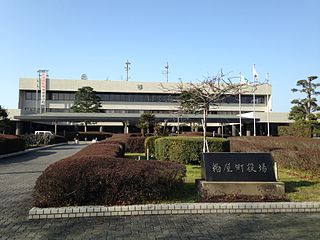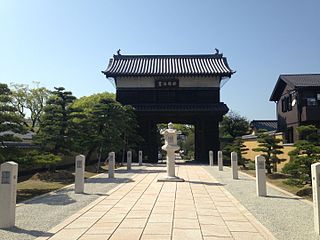
Fukuoka is the sixth-largest city in Japan and the capital city of Fukuoka Prefecture, Japan. The city is built along the shores of Hakata Bay, and has been a center of international commerce since ancient times. The area has long been considered the gateway to the country, as it is the nearest point among Japan's main islands to the Asian mainland. Although humans occupied the area since the Jomon period, some of the earliest settlers of the Yayoi period arrived in the Fukuoka area. The city rose to prominence during the Yamato period. Because of the cross-cultural exposure, and the relatively great distance from the social and political centers of Kyoto, Osaka, and later, Edo (Tokyo), Fukuoka gained a distinctive local culture and dialect that has persisted to the present.

Fukuoka Prefecture is a prefecture of Japan located on the island of Kyūshū. Fukuoka Prefecture has a population of 5,109,323 and has a geographic area of 4,986 km2. Fukuoka Prefecture borders Saga Prefecture to the southwest, Kumamoto Prefecture to the south, and Ōita Prefecture to the southeast.

Hakata-ku (博多区) is a ward of the city of Fukuoka in Fukuoka Prefecture, Japan.

Dazaifu is a city located in Fukuoka Prefecture, Japan. As of 31 March 2024, the city had an estimated population of 71,505 in 33204 households, and a population density of 260 persons per km². The total area of the city is 29.60 km2 (11.43 sq mi).

Kasuya is a town located in Kasuya District, Fukuoka Prefecture, Japan. As of 31 March 2024, the town had an estimated population of 48,731 in 21931 households, and a population density of 250 persons per km². The total area of the town is 14.13 km2 (5.46 sq mi)

Shōfuku-ji (聖福寺) is a Buddhist temple located in the Gokushōmachi neighborhood of Hakata, Fukuoka, Japan. It belongs to the Rinzai school Myōshin-ji-branch of Japanese Zen. Its sangō prefix is Ankokuzan (安国山). It was founded by Eisai with support from Minamoto no Yoritomo, is the oldest Zen temple in Japan. Its precincts were designated a National Historic Site in 1969.

Sōfuku-ji (崇福寺) is a Rinzai temple in Hakata-ku, Fukuoka, Japan. Its honorary sangō prefix is Yokodakezan (横岳山). The temple was founded by the monk Tan'e (湛慧) in Dazaifu in 1240, but was moved to its present location in 1600 after it became the Kuroda family temple.

Mount Hōman, is a mountain on the border between the cities of Chikushino and Dazaifu in Fukuoka Prefecture in Kyūshū, Japan. It has an elevation of 829.6 metres (2,722 ft) meters. It is regarded as a sacred mountain and one of the three major centers for Shugendō. It was designated a National Historic Site in 2013. The mountain is also called Mount Mikasa (御笠山) and Mount Kamado (竈門山)
The Hara Kanga ruins is an archaeological site with the ruins of a Nara to Heian period government administrative complex located in what is now the cities of Kumagaya and Fukaya in Saitama prefecture in the Kantō region of Japan. The site consists of the Hara kanga ruins (幡羅官衙遺跡), and the Nishi-Fuchibe Ritual Site ruins (西別府祭祀遺跡). The ruins were protected as a National Historic Site in 2018. After the Mirokuji kanga ruins in Gifu prefecture, it is the second example where the ritual complex was located together with the administrative site.
The Kyōgoku clan ruins is a group archaeological sites in the Johei neighborhood of the city of Maibara, Shiga prefecture in the Kansai region of Japan, connected with the Muromachi period rulers of northern Ōmi province, the Kyōgoku clans. The sites have protected as a National Historic Site from 2004.

The kōrokan were guest houses for foreign ambassadors, traveling monks, and merchants that existed in Japan from the Asuka period to the end of the Heian period. These guest houses existed in Fukuoka, Osaka and Kyoto. The word kōrokan (鴻臚館) was coined in the Heian period by using the first two characters from the Chinese name 鴻臚寺 for Han dynasty and Qi dynasty temples charged with the responsibility of hosting foreign dignitaries. Only the location of the kōrokan in Fukuoka is known with precision today; its ruins were discovered on the grounds of Maizuru Castle Park in 1987 and were designated a National Historic Site in 2004. The guest house in Fukuoka is called Tsukushi Kōrokan (筑紫の鴻臚館), after the name of Tsukushi Province, which is part of Fukuoka Prefecture today

The Ogōri Kanga ruins complex is an archaeological site with the ruins of a Nara to Heian period government administrative complex located in what is now the city of Ogōri in Fukuoka prefecture in northern Kyushu, Japan. The site has been protected as a National Historic Site from 1971 with the area udner protection expanded in 2001.

The Shimotakahashi Kanga ruins is an archaeological site with the ruins of a Nara to Heian period government administrative complex located in what is now the town of Tachiarai in Fukuoka prefecture in northern Kyushu, Japan. The site has been protected as a National Historic Site from 1998.
The Dainose Kanga ruins is an archaeological site with the ruins of a Nara to Heian period government administrative complex located in what is now the town of Kōge in Fukuoka prefecture in northern Kyushu, Japan. The site has been protected as a National Historic Site from 1998.

Mount Kubote is a mountain on the border of the city of Buzen and the town of Chikujō, in Fukuoka Prefecture, Japan. It is 782 metres (2,566 ft) in height. It is within the borders of the Yaba-Hita-Hikosan Quasi-National Park. Noted for its connections to the Shugendō mountain cult it was designated a National Historic Site of Japan in 2001.
The Fukubaru Chōjabaru Kanga ruins is an archaeological site with the ruins of a Nara period government administrative complex located in what is now the Minamiizumi neighborhood of the city of Yukuhashi in Fukuoka prefecture in northern Kyushu, Japan. The site has been protected as a National Historic Site from 2017.
The Ae Kanga ruins阿恵官衙遺跡 is an archaeological site with the ruins of an Asuka to Nara period government administrative complex located in what is now the town of Kasuya in Fukuoka prefecture in northern Kyushu, Japan. The site has been protected as a National Historic Site from 2020.
Daibu temple ruins is an archeological site with the ruins of the foundations of a Japanese pagoda from a Nara period Buddhist temple located in the city of Iizuka, Fukuoka, Japan. It was designated as a National Historic Site in 1941.

Itazuke Site is an archeological site with a late Jōmon period to late Yayoi period settlement located in Hakata-ku, Fukuoka, Japan. Along with the Nabatake Site in Karatsu, Saga, it is the oldest known rice-growing village site in Japan, and is also the oldest known moated settlement. It was designated as a National Historic Site in 1976, with the area under protection expanded in several times.
Imayama Site is an archeological site with the ruins of a Yayoi period stone tool production site located in the Yokohama neighborhood of Nishi-ku, Fukuoka, Japan. It was designated as a National Historic Site in 1993, with the area under protection expanded in 2003.
















